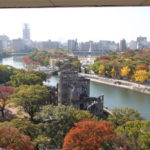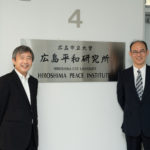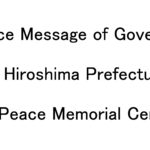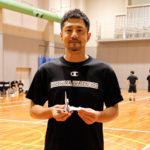III The Hiroshima Peace Memorial City Construction Plan: Project Implementation and Effects
1 The results of the Hiroshima Peace Memorial City Construction Law
On August 6, 1949, the Hiroshima Peace Memorial City Construction Law was enacted, and an additional budget of approximately 31 million yen was allocated from the national government as a special subsidy that fiscal year. In 1950, 180 million additional yen was provided during the fiscal year. Under this special framework, Hiroshima and Nagasaki continued to receive higher subsidies to cover the costs of their reconstruction projects. The national government subsidized two-thirds of the costs of the “peace memorial facilities,” a high rate at the time. In this way, the national government supported the construction costs of the Peace Memorial Museum and the development costs of the Peace Memorial Park. Many properties of the national government were also transferred to Hiroshima. For example, land transferred from the national government was used to build Hakushima Elementary School and Yoshijima Elementary School, Futaba Junior High School and Noboricho Junior High School, Motomachi Senior High School, the water facilities in Ushita, and the Hiroshima Citizens Hospital.
The benefits of the Hiroshima Peace Memorial City Construction Law were not only limited to special assistance from the national government. The law also provided moral support to the citizens by assuring them that the national government was watching over and assisting them. The efforts made by those in Hiroshima were not the only factors that played important roles in Hiroshima’s reconstruction process; the support framework as well as physical and moral support played a significant role.
2 Characteristics of the Implemented Plan – Particularly the 100-meter Wide Road
The reconstruction plan of Hiroshima was unique in character. Specifically, there were three main unique characteristics to the Peace Memorial City Construction Plan.
In the initial 1946 reconstruction plan, the Hijiyama-Kogo Line was one of the wide roads and part of the line that extends over 3,570 meters was 100 meter wide. Therefore this part was called “100-meter road” (Photo 4-2). In November 1951, it was named the “Peace Boulevard”―a name selected from among submissions from the general public. At that time, there was another plan to construct a 100-meter wide road about two kilometers south from the Peace Boulevard. This was called the Deshio-Kogo Line (later renamed the Kasumi-Kogo Line). The 100-meter wide road portion of this line’s plan was cancelled following a nationwide review of the reconstruction plans of war-damaged cities (conducted in 1949). The bridges constructed to the southeast and the southwest of the new Peace Memorial Park were named the Heiwa-ohashi Bridge (the Peace Bridge) and the Nishi Heiwa-ohashi Bridge (the West Peace Bridge), respectively. The writer Yoko Ota details the problems surrounding the 100-meter road in Yunagi no Machi to Hito to: 1953 Nen no Jittai (A City and its People in the Evening Calm: Realities of 1953)―about people who criticized the 100-meter road at the time.
This criticism peaked during Hiroshima’s April 1955 mayoral election. Though deemed to have made enough achievements in the reconstruction process of the city during his two terms of office, incumbent Shinzo Hamai lost the election to Tadao Watanabe, who had called for a review of the city planning. In particular, Watanabe called for the reduction of the width of the 100-meter road by half and the construction of public housing for the citizens. Later, Mayor Watanabe withdrew his campaign promise and in 1957 and 1958, trees were planted along the greenbelt in the center of the city, through the tree donation and planting campaigns. In this way, the landscape of the city gradually developed.
3 Support from Overseas
It must be mentioned that Hiroshima’s reconstruction was not only supported by the national government. It also received support from overseas. In 1949, Dr. Floyd Schmoe paid a visit to Hiroshima to build and provide homes for survivors of the bomb. This marked the beginning of the Houses for Hiroshima―also known as the Schmoe House project. Afterwards, he came back to Hiroshima many times and built 20 housing units and a community center, in Minami-machi, Eba (Nihonmatsu 1 chome) and at other places and donated them.
Relief supplies and donations were sent to support bomb victims in Hiroshima by those originally from Hiroshima who had moved abroad to Hawaii and the mainland of the United States, Canada, Brazil, Peru and other countries. In fact, the Hiroshima Kenjinkai in Hawaii formed the Hawaii Society for Relief of Hiroshima War Victims in April 1948 to fundraise and remitted donations to support reconstruction costs. In this same way, the Children’s Library in Chuo Park in Moto-machi was built with donation made by the Hiroshima Kenjinkai of Southern California in the United States. This was built based on Kenzo Tange’s 1952 design, with a concrete shell in the shape of a mushroom and glass walls. It was opened in 1953 and became a popular place for children to read books (Photo 4-3). Additionally, the Peace Bridge and the West Peace Bridge were both built as national projects with the Collateral Fund of U.S. Assistance to Japan.
While not a direct form of assistance, the CIE Library (later the American Culture Center) built along the 100-meter road was also valuable for Hiroshima, which had very few cultural facilities.
Much of the Memorial Cathedral for World Peace’s equipment (a Catholic church built in Nobori-cho) was donated from various countries, including a pipe organ from Cologne, Germany (then West Germany); four peace bells from a steel company in Bochum; the front doors from Düsseldorf; the pulpit from Munich; a mosaic mural from Konrad Adenauer, the Chancellor of West Germany at that time; a baptismal font from Aachen; and an altar from Belgium. Additionally, the stained glass windows that bring light into various places of the cathedral and create an atmosphere were donated from countries such as Germany, Austria, Portugal, Mexico, a church in Munich and others. While these items were given to the Noboricho Church, which constructed the Memorial Cathedral, in most cases, donors had also intended that the items to be gifts to the people of Hiroshima. As citizens of Hiroshima, and as Japanese people, we must remember those who donated these gifts and their thoughts.
Notes and References
Tags associated with this article








